Hanover
![]()
The title of this article is ambiguous. For other meanings, see Hannover (disambiguation).
Hannover (![]()
![]() [haˈnoːfɐ]) is the capital of the state of Lower Saxony. Located on the southern edge of the North German Lowlands on the Leine and Ihme rivers, it was first mentioned in 1150 and received its city charter in 1241. Hanover was a Guelph royal seat from 1636, a residence of the Electorate of Hanover from 1692 and the capital of the Kingdom of Hanover from 1814. From 1714 to 1837 there was a personal union between Great Britain and Hanover, according to which the kings of Hanover were also the kings of Great Britain. After the annexation of the Kingdom of Hanover by Prussia, Hanover became the capital of the Province of Hanover from 1866, and after the dissolution of Prussia in August 1946, the capital of the State of Hanover. Since its merger with the Free States of Brunswick, Oldenburg and Schaumburg-Lippe in November 1946, Hanover has been the capital of Lower Saxony. A major city since 1875, it is now one of the 15 most populous cities in Germany with just under 540,000 inhabitants.
[haˈnoːfɐ]) is the capital of the state of Lower Saxony. Located on the southern edge of the North German Lowlands on the Leine and Ihme rivers, it was first mentioned in 1150 and received its city charter in 1241. Hanover was a Guelph royal seat from 1636, a residence of the Electorate of Hanover from 1692 and the capital of the Kingdom of Hanover from 1814. From 1714 to 1837 there was a personal union between Great Britain and Hanover, according to which the kings of Hanover were also the kings of Great Britain. After the annexation of the Kingdom of Hanover by Prussia, Hanover became the capital of the Province of Hanover from 1866, and after the dissolution of Prussia in August 1946, the capital of the State of Hanover. Since its merger with the Free States of Brunswick, Oldenburg and Schaumburg-Lippe in November 1946, Hanover has been the capital of Lower Saxony. A major city since 1875, it is now one of the 15 most populous cities in Germany with just under 540,000 inhabitants.
The city and the former district have merged to form a special kind of municipal association, the Hannover Region, which is part of the Hannover-Braunschweig-Göttingen-Wolfsburg metropolitan region. In and near Hannover, important rail and road routes of the north-south and east-west directions intersect; the main train station and the airport are each among the top 10 in Germany. The city is connected to the inland waterway network by several ports via the Mittelland Canal. From the 13th century until about 1620, Hannover was a Hanseatic city and has been a member of the New Hanseatic League since late June 2019. Hannover is the seat of the Evangelical Church in Germany and the headquarters of the World Communion of Reformed Churches. Hanover is considered the city where the purest High German is spoken.
Hannover is home to eleven universities and several libraries. The correspondence of Gottfried Wilhelm Leibniz and the Golden Letter, kept in the Gottfried Wilhelm Leibniz Library, are part of the UNESCO World Document Heritage. Hanover is an important research and business location as well as a nationally significant shopping city. The cultural scene is considered diverse with numerous theaters, museums and international theater, music and dance festivals. Hanover has been a UNESCO City of Music since 2014. Hannover is also an important sports city. The cityscape is characterized by numerous public green spaces, a high density of street art and numerous architectural monuments, including representative buildings of the North German Brick Gothic, the Hanoverian School of Architecture, Brick Expressionism and Classicism. The Hannover Adventure Zoo, the Maschsee lake and the Herrenhausen Gardens with Herrenhausen Palace are known beyond the region; the arched elevator in the New Town Hall is a worldwide rarity. The German Michel is buried in the Marktkirche. With the world's largest exhibition center and numerous world-leading trade fairs, Hannover is one of the leading trade fair cities in Europe. The world's largest marksmen's festival is held annually, and since 1955 Hannover has held the official honorary title of "Schützenstadt" (City of Marksmen). The Maschseefest is the largest lake festival in Germany.

Maschsee

Schützenfest Hannover 2014 from above

The Golden Gate in the Herrenhausen Gardens
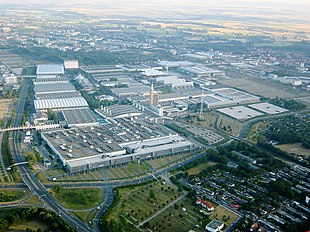
Hanover Exhibition Grounds from the north, March 2008
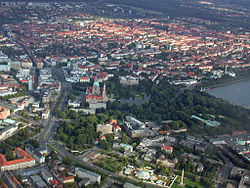
New City Hall with Maschpark, Aegidienkirche, administration building of Nord/LB, State Museum, Südstadt, on the right the Maschsee lake
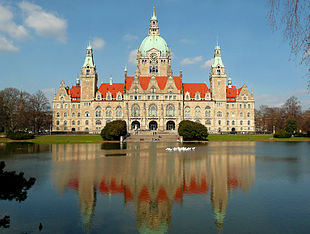
New City Hall, Hanover's landmark (Lage52 .3672679 .737365 )
Geography
Location
Hannover is located in the valley of the Leine River at the transition of the Lower Saxony Uplands to the North German Lowlands, the city center at 52°22'28" N and 9°44'19" E. In the southwest of the city, the foothills of the Weserbergland with fertile loess soils, in the north the sandy and marshy Geest landscapes of the Burgdorf-Peiner and the Hannoversche Moor-Geest border the city area.
The natural and traffic geographic location offered Hannover favorable conditions for the development from a medieval village to a large city. In the Middle Ages, an important north-south trade route through the Leine valley passed through the town at a ford in the river. In the 19th century, the railroad followed this course and due to the construction of the Mittellandkanal as an east-west connection in the 20th century, Hannover was located at the intersection of these important traffic routes. The same applies to road traffic due to the intersection of the federal highways A 2 and A 7 near Hannover.
See also: Traffic
The nearest major cities are Hildesheim, Salzgitter, Braunschweig, Wolfsburg, Bielefeld and Göttingen. The North Sea coast is somewhat closer to Hannover than the Baltic Sea coast.
|
|
|
|
|
|
|
|
|
|
|
|
* Distances are rounded road kilometers to the town center.
Neighboring communities
The following cities and municipalities in the Hannover Region border the city of Hannover: Langenhagen, Isernhagen, Lehrte, Sehnde, Laatzen, Hemmingen, Ronnenberg, Gehrden, Seelze and Garbsen. The surrounding area is characterized by urban development along the traffic axes and rural construction in other parts. Approximately 1,130,000 people lived in the Hannover metropolitan area in 2019.
City breakdown
→ Main article: List of Hanover's boroughs and districts
Hannover consists of 51 city districts. Two to seven of these districts are combined to form a borough, so that the following 13 boroughs exist: Mitte, Vahrenwald-List, Bothfeld-Vahrenheide, Buchholz-Kleefeld, Misburg-Anderten, Kirchrode-Bemerode-Wülferode, Südstadt-Bult, Döhren-Wülfel, Ricklingen, Linden-Limmer, Ahlem-Badenstedt-Davenstedt, Herrenhausen-Stöcken and Nord.
More than eleven percent of the city's approximately 200 square kilometers are public green spaces, which is why Hannover is also referred to as a large city in the green. The Eilenriede city forest near the city center alone covers 650 hectares.
Topography
Waters
To the south of the city center is the Maschsee, an approximately 78-hectare man-made lake with no natural inflow or outflow.
Coming from the south, the Leine flows through Hannover northwest toward the Aller. At the level of the Maschsee lake, the Schneller Graben conducts Leine water to the Ihme. The weir there serves not only to regulate the water level but also to generate electricity. The Ihme is a small stream coming from the Calenberger Land. Through the supply of Leine water it becomes a river, which joins the Leine again after a few kilometers. From here on the Leine is navigable. In Limmer, the Fösse flows into the Leine.
Terrain
Hannover lies on average 55 meters above sea level. The highest natural elevations in the city area are the Kronsberg, located on the southeastern edge, whose highest point at 118.2 meters is a viewing hill artificially raised by several meters, and the 89.0 meter high Lindener Berg. The highest artificial elevation is the Nordberg with 122 meters on the northeast edge on the site of the Lahe landfill. The lowest point is in the Klosterforst Marienwerder landscape conservation area and is 44 meters above sea level.
Climate
Hannover is located in a region with a maritime climate (type Cfb). The annual mean temperature is about 10.6 °C. In the long-term average, the air temperature in Hannover reached 8.7 °C and 661 millimeters of precipitation fell. Between May and August, an average of 22 summer days (climatological term for days when the maximum temperature exceeds 25 °C) can be expected.
| Hanover | ||||||||||||||||||||||||||||||||||||||||||||||||
| Climate diagram | ||||||||||||||||||||||||||||||||||||||||||||||||
| ||||||||||||||||||||||||||||||||||||||||||||||||
| Monthly average temperatures and precipitation for Hannover
Source: DWD, data: 2015-2020 | |||||||||||||||||||||||||||||||||||||||||||||||||||||||||||||||||||||||||||||||||||||||||||||||||||||||||||||||||||||||||||||||||||||||||||||||||||||||||||||||||||||||||||||||||||||||||||||||||||||||||||||||||||||||||||||||||||||||||||||||||||||||||||||||||||||||||||
Nature and landscape reserves
The flora-fauna-habitat (FFH) areas Altwarmbüchener Moor, Mergelgrube near Hannover, Leineaue between Ruthe and Hannover, Bockmerholz-Gaim as well as Aller (with Barnbruch), lower Leine, lower Oker are partly located in the city area. Partially included in this are the nature reserves Bockmerholz, Mergelhalde and Gaim, which lie wholly or partly within the city area, as well as the landscape protection areas Wietzeaue, Obere Wietze, Laher Wiesen, Kugelfangtrift-Segelfluggelände, Altwarmbüchener See, Altwarmbüchener Moor-Ahltener Wald, Mardalwiese, Breite Wiese-Nasse Wiese, Alte Bult, Kronsberg, Obere Leine, Hirtenbach/Wettberger Holz, Benther Berg Vorland/Fössetal, Mittlere Leine and Mecklenheide/Vinnhorst.
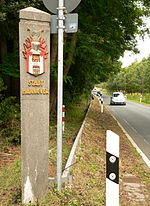
Border post with coat of arms on the Lenther Chaussee at the town border
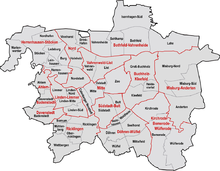
City districts and boroughs of Hannover
.png)
Hanover and surroundings
History
→ Main article: History of the city of Hannover
Traces of settlement, foundation and first flowering
Traces of a settlement "of no small extent" from the Roman imperial period (1st to 3rd century AD) were found in the area of the later Old and New Towns of Hanover, as the city historian Helmut Plath wrote. Remains of clay vessels from this period were found under the Aegidien Church. A denarius of the Roman emperor Severus Alexander (222-235) was recovered in an old linen arm, for Plath the proof that the settlement "was reached by trade connected with the Romans." The settlement of unknown name could be identical with the place Touliphourdon (Latin: Tulifurdum), which the geographer Claudius Ptolemy marked in a map of Germania Magna made around 150 AD. Scientists of the Institute of Geodesy of the Technical University of Berlin located Tulifurdum in 2010 by means of a new map projection "near Hannover". Linguistically, the name has been interpreted as a composition of the Latin words tuli ("I have carried") and furdum ("ford"), which could refer to Hannover's crossing of the Leine.
Today's Hannover developed from a medieval settlement on a flood-protected site on the banks of the Leine. This location probably gave the later city of Hannover its name - Honovere = "(At) the high bank" - which is, however, disputed (see Naming). Nearby there was a possibility to cross the Leine at a shallow ford due to the only 500 m wide Leine lowland and a Werder. Two long-distance roads crossed there. Even today, the road that runs parallel to the Leine at this point is called Am Hohen Ufer. There are already indications of a market settlement at this place from the time around the year 950. The Vicus Hanovere (vicus = "market town") was first mentioned around 1150 in the Hildesheim Miracula Sancta Bernwardi. In the 12th century, Henry the Lion had Hanover expanded and enfeoffed the Counts of Roden with it, who ruled from Lauenrode Castle, a moated castle in the Leine lowlands near Limmer. In 1241 Hanover received the city privilege; since this time there is also evidence of a council. Towards the end of the 13th century, the city was headed by two mayors. In addition, there was a so-called sitting council consisting of twelve members with the ruling mayor. In 1371, during the Lüneburg War of Succession, the town was granted the Great Privilege, which gave it extensive rights, such as customs and mill rights and the fortification of the town.
To protect the city, an eight-meter-high city wall with 34 wall towers replaced the previously existing fortification of palisaded ramparts and ditches from 1350. From 1392 onwards, the city fortifications of Hanover also included a landwehr, which secured the city's apron. Of the former Hanoverian Landwehr with ramparts, hedges, guard houses and towers, there are still installations such as the tower on the Lindener Berg, the Döhrener Turm, the Pferdeturm, the Lister Turm and others. The city experienced its first economic prosperity at this time and joined the Hanseatic League. Membership probably began as early as the 13th century, but certainly in the 14th century. The long-distance trade of Hanoverian merchants in the 15th century involved, for example, the export of linen to London, the cloth trade with Flanders, the import of furs and hides from Novgorod, of fish oil and wax from Norway, and of herring and butter from southern Sweden. The interconnectedness of the economy through the Hanseatic League began to weaken in the 16th century. Hanover left the Hanseatic League around 1620. In 1636 Hannover was elevated to the Guelph residence. The population increased to 4000.
During the time of the Reformation, there was a growing inclination among the population to accept the Protestant doctrine. On June 26, 1533, an assembly in the marketplace vowed to stand together on Luther's word. Although the leading circles of the city did not join the Reformation, it was enforced by the opposition of the citizens who did not hold political office. The city council eventually had to flee to Hildesheim, which remained an Old Believer. In 1580, "the mayor and council of the city of Hanover" signed the Lutheran Formula of Concord of 1577.
In Hanover, at least 30 people were accused in witch trials from 1514 to 1657, 27 of whom were executed at the stake or died in prison. The last victim of the witch hunt was Alheit Snur in 1648.
Fortress and residence city
During the Thirty Years' War, Duke Georg von Calenberg made the fortress-like city his residence in 1636. As a residential city, Hanover experienced a renewed period of prosperity in the following 80 years. The buildings of this epoch in Hannover's history set lasting accents in the cityscape.
In 1676, Gottfried Wilhelm Leibniz (1646-1716) was appointed court councilor and head of his library by Duke Johann Friedrich. The Leipzig-born philosopher and mathematician, who among other things invented the dual system, lived in Hannover until his death. In 2005, the state library and in 2006 the university were named after him.
From 1699 the council included two mayors, one syndic, one secretary, two chamberlains and six senators. From 1725 to 1761 Christian Ulrich Grupen was always one of the mayors of the city.
Hanover was the 9th electorate of the Holy Roman Empire from 1692 (official name: Chur-Braunschweig-Lüneburg, unofficially also Chur-Hannover, Kurhannover or Hanover), after Duke Ernst August had introduced primogeniture as a prerequisite in 1682.
After Elector Georg Ludwig ascended the British throne as George I in 1714, he moved his residence from Hanover to London. In Hanover, this consolidated a circle of noble and civil servant families in the internal administration. The residential town, which had been heavily dependent on the court in the years before, became increasingly deserted in the process. Even the palace and gardens of Herrenhausen were soon no longer in use. It is ultimately thanks to this circumstance that the garden was no longer rebuilt in a contemporary manner and that the original baroque state was preserved.
This changed in 1837, when the 123-year personal union of the kingdoms of Great Britain and Hanover came to an end with the death of William IV and King ErnstAugust I ascended the throne in Hanover. On October 22, 1843, the railroad line from Hanover to Lehrte was opened, and on May 19, 1844, the Hanover-Braunschweig railroad line was open to traffic throughout. The conservative king had initially resisted the connection of his residential city to the emerging railroad network. Because of his skepticism, the Royal Hanoverian State Railways planned the first branching lines not in Hanover, but in Lehrte.
In 1747, Aegidienneustadt was incorporated, followed by Calenberger Neustadt in 1824 and Ernst-August-Stadt in 1847. With the incorporation of the suburbs of Hanover in 1859 with the villages Königsworth, Schloßwende, Nordfeld, Vorort, Fernrode, Bütersworth, Kirchwende, Bult, Heidorn, Tiefenriede, Emmerberg and Kleefeld, the city area grew from 157 to 2354 hectares and the population increased from 38,000 to 68,000.
Hanover was an autonomous city within the Kingdom of Hanover. In 1823 it became the seat of the Landdrostei Hannover, which later became the Regierungsbezirk Hannover. In 1824, it became the seat of the Amt Hannover, which was formed by uniting the Gerichtsschulzenamt Hannover and the Amt Koldingen. From 1825, Hanover had a magistrate's college, which lasted until 1935. During this time, the head of Hanover bore the title of city director.
Prussian provincial capital
In the German War of 1866, the Kingdom of Hanover under George V fought on the side of the German Confederation and Austria against Prussia and achieved a Pyrrhic victory in the Battle of Langensalza, because shortly after the battle the Hanoverian army had to surrender. As a result, Hanover was annexed by Prussia and thus became a Prussian province: the residential city of Hanover became a Prussian provincial capital.
For Hanoverian industry, the annexation to Prussia meant an improvement in the general conditions. The abolition of compulsory guilds and the introduction of freedom of trade promoted economic growth and led to the boom of the Gründerzeit. In the period between 1871 and 1912, the population grew from 87,600 to 313,400. The threshold for a large city with 100,000 inhabitants was crossed in 1873.
In 1872, the first horse-drawn streetcar was inaugurated, which was further developed into an electric streetcar from 1893. In 1881, Ferdinand Sichel invented the first ready-to-use wallpaper paste.
The boom in Hanover came during the era of city director Heinrich Tramm. He was elected to this office in 1891 and held it for 27 years. During this time, he was the dominant figure in the city's politics and administration.
In 1883, Hanover became a district-free city and the seat of the district of Hanover, which was created from the Amt Hanover, as well as the administrative district of Hanover, which emerged from the Landdrostei Hanover.
The city was enlarged in 1870 with the suburb of Ohe-Glocksee, followed in 1882 by Königsworther Platz and Welfengarten, in 1891 by the municipalities of Herrenhausen, Hainholz, Vahrenwald and List, and on October 1, 1907 by the municipalities of Stöcken, Bothfeld, Klein-Buchholz, Groß-Buchholz, Kirchrode, Döhren and Wülfel, as well as the Mecklenheide estate district and the Kirchrode-Stadt land register district.
In 1902, Hermann Bahlsen installed one of Germany's first neon signs.
Weimar Republic
In 1920, the town of Linden with the districts of Alt- and Neu-Linden, Limmer, Davenstedt, Badenstedt, Bornum and Ricklingen was incorporated into Hannover. As a result, the population grew by about 80,000 to 400,000. In 1928, the Herrenhausen palace and garden district, the Leinhausen and Marienwerder estate districts followed, and in 1937 parts of Bemerode and Laatzen.
Since 1918, the head of the city has been called lord mayor and no longer city manager. The first mayor was the Social Democrat Robert Leinert. In 1925, he was succeeded by Arthur Menge of the conservative DHP, who remained in office until 1937. In 1936, Menge's term of office included the construction of the Maschsee lake and the Hermann Löns Park, which had been made possible by job creation measures.
In cultural terms, Hanover was a "suburb of modernism" in the 1920s, especially because of Kurt Schwitters. His Dadaism, his magazine MERZ and the group he founded, die abstrakten hannover, had a worldwide reputation.
In the time of National Socialism
From 1937, the Lord Mayor (1942-1945 "State Commissioner") belonged to the NSDAP. As everywhere in Germany, many people in Hanover faced persecution because of their Jewish faith and other ethnic and other reasons. 484 Hanoverian Jews of Polish origin were expelled to Poland as part of the "Polish Action" at the end of October 1938, including the Grünspan family. Their second oldest son Herschel Grynszpan was in Paris. When he learned of his family's expulsion, he drove to the German embassy and shot Legationsrat Ernst Eduard vom Rath, who died two days later. The National Socialists used this act as a pretext for the November pogroms they staged throughout Germany. On November 9, 1938, the New Synagogue in Hanover's Calenberger Neustadt was burned down. In September 1941, the "Aktion Lauterbacher" initiated by the NSDAP Gauleiter Süd-Hannover-Braunschweig led to the ghettoization of the remaining Jewish families.
Even before the Wannsee Conference, the first 1001 Jews from Hanover were deported to Riga on December 15, 1941. Until 1945, at least 2400 people had to leave the city in eight transports, few of whom survived. The deportations of the Jews and the "Aryanization" of art and cultural assets were organized by the city's building councilor Karl Elkart. Of the approximately 4800 Jews who lived in Hanover in 1938, there were not a hundred left when troops of the U.S. Army entered the city on April 10, 1945. Today, the persecution of Jews in Hanover is commemorated by a memorial on Opernplatz and more than 400 Stolpersteine (2018) laid in the sidewalk in front of the last freely chosen homes of Nazi victims. In Ahlem, a memorial was established in 1987 on the grounds of the former Israelite Horticultural School.
See also: History of the Jews in Hanover
In addition to a forced labor camp for Sinti and Roma and so-called education camps, there were several subcamps of the Neuengamme concentration camp in Hanover with several thousand inmates who lived in inhumane conditions. During the war, about 60,000 forced laborers worked in Hannover, most of them deported from the USSR, Poland, France, the Netherlands and Belgium and interned in about 500 camps. They were mainly employed in the armaments industry. Four days before Hanover was liberated, 154 of them were shot in the Seelhorst city cemetery. Shortly after the end of the war, they were transferred along with another 230 bodies in a funeral procession to the north shore of the Maschsee and buried there in a memorial.
During World War II, numerous divisions and military administrations had their headquarters in Hanover. These included nine military courts, before which soldiers who had refused to obey were also sentenced to death. The data of 51 soldiers were determined who were executed for "desertion" (Fahnenflucht), "Wehrkraftzersetzung" and "Kriegsverrat" in Hanover or originating from Hanover elsewhere. There was also isolated resistance in Hanover, ranging from armaments sabotage and deviant youth behavior to the preparation of an overthrow by communist, social democratic and bourgeois parties. After the assassination attempt of July 20, 1944, about ninety people were arrested in the Hanover-South Lower Saxony area, including the later SPD chairman Kurt Schumacher.
As an important transportation hub and the location of war-related businesses, Hannover was the target of more than a hundred Allied air raids starting in 1940. In the process, 48 percent of the city was destroyed - ranking seventh among Germany's major cities - and 6782 people were killed; 50 percent of residential buildings and 40 percent of industrial jobs were destroyed. The Aegidienkirche was not rebuilt; its ruins serve as a memorial to the victims of war and tyranny. On April 10, 1945, the 9th U.S. Army occupied Hanover; the war in Europe ended on May 8 with the unconditional surrender of the Wehrmacht.
Reconstruction and development to the present
In 1946, the military government of the British occupation zone introduced the municipal constitution based on the British model. The council, elected by the people, elected the honorary mayor from among its members as chairman and representative of the city. Herbert Schmalstieg was mayor for many years from 1972 to 2006. From 1946 to 1996, the city administration was headed by a full-time mayor, who was also elected by the council.
After the war, the city was rebuilt in a systematic and rigorous manner under the direction of Rudolf Hillebrecht: After the severe destruction caused by the war, the former urban structure and street network, which tended to emphasize "small parts", were completely reorganized and adapted to the then postulated requirements of a "car-friendly city". Especially the city center in the central area of Ägidientorplatz and Georgstraße was bypassed with multi-lane roads (Lavesallee, Leibnizufer, Hamburger Allee, Berliner Allee) and their linkage was established by traffic circles. The long-distance traffic of the former Reichsstraße No. 3 and No. 6, which used to flow through the center, was routed around the center via expressways.
For the Messeschnellweg, a cutting was made through the middle of the Eilenriede city forest. The historic city layout remained only superficially, as the remaining coarse-meshed network of streets only roughly traces the main lines of the historic streets. Characteristic of Hannover's reconstruction is the emergence of urban spaces that deviate from the historic structure.
Through this urban planning, which was considered exemplary at the time and still has an impact today, the city achieved national fame. In later times, the urban planning concepts of the reconstruction period proved to be outdated: In the architectural trend of postmodernism, those street layouts and squares that had characterized the 19th century took on model character again, rather than post-war urban planning, which had uncritically adopted concepts from the USA with its car-oriented planning. The loss of historic building fabric due to the air raids and the planning of the post-war period (see also: List of Departed Buildings in Hanover) led to the desire for reconstructions of formerly characteristic buildings in individual cases: For example, the facades of the Leibnizhaus, destroyed during the war, were rebuilt by 1983, and those of Herrenhausen Palace in the Great Garden by 2013.
In 1951, the first Federal Horticultural Show was held in Hannover City Park.
In 1965, the city council decided to build a subway. Decades of construction work on the tunnel network followed, which was essentially completed in 1993 with the opening of the C-Nord line in Nordstadt. Tunnels were built in the inner city area and these were connected to the existing streetcar lines, creating the Hannover light rail system. After the end of the construction work, pedestrian zones were established in the city center around Kröpcke and in the Lister Meile, giving these areas a considerable upgrade.
After parts of Wettbergen had already been incorporated in 1967 and 1968, the major Lower Saxony territorial reform followed on March 1, 1974: The town of Misburg and the municipalities of Ahlem, Anderten, Bemerode, Vinnhorst, Wettbergen, Wülferode were incorporated, as were parts of Isernhagen Niedernhägener Bauerschaft (today Isernhagen-Süd), Laatzen and Langenhagen. On January 1, 1981, parts of the area with more than 100 inhabitants at that time were ceded to the neighboring town of Laatzen. On November 1, 1981, the division of the town into 13 districts came into effect on the basis of the Lower Saxony Municipal Code.
After Hanover had already hosted the 13th German Fire Brigade Day in 1888, the 25th German Fire Brigade Day was also held there from June 7 to 15, 1980. The 29th Firefighters' Day, together with Interschutz (both held in Hannover), was initially postponed from 2020 to June 2021, then to June 2022, due to the COVID 19 pandemic.
Expo 2000 was the first world exhibition to be held in Germany, in Hanover. 155 nations participated in the exhibition with the motto "Man, Nature, Technology. With 18 million visitors, the initial expectations for visitor numbers were not met.
Until the abolition of the four district governments of Lower Saxony on December 31, 2004, the city was the seat of the district government of Hanover.
In 2019, Hanover became a Hanseatic city again. The readmission to the League of Cities took place at the Assembly of Delegates in the Russian city of Pskov.
Population development
→ Main article: Population development of Hannover
Until the end of the early modern period, Hanover's population grew only slowly. During the late Middle Ages, about 5,000 people lived in the city in 1435; by 1766, the number had more than doubled to 11,874. Population growth accelerated with the onset of the Industrial Revolution at the end of the 18th century. In 1811, 16,816 people lived in the town. The incorporation of surrounding towns (Vorstadt Hannover) with about 20,000 people in 1859 led to an increase to 60,120 people in 1861.
With the high industrialization in Germany, Hannover became a big city in 1875. In 1901, there were 250,000 inhabitants. Incorporations in 1907 and 1909 increased the population to over 300,000 in 1910. On January 1, 1920, the city of Linden was incorporated with 73,379 inhabitants (1919). The population rose to over 400,000 by the end of 1920.
In the course of World War II, the city lost more than half of its inhabitants: in addition to the deportation of Jews, the population dropped from 471,000 in May 1939 due to flight and evacuation such as the Kinderlandverschickung to 217,000 people in April 1945. In 1952, as many people lived in the city as before the war, and in 1954, half a million. In 1962, the population reached its historic high of 574,754. On March 1, 1974, the incorporation of the town of Misburg with 21,721 inhabitants (1972) and other surrounding towns brought a population increase of 64,711. Hannover has been one of the 15 largest German cities in every year since 1960 at the latest. As of June 30, 2019, the official population was 536,055, and the population according to the population register was 545,107. At the turn of 2019/2020, the population according to the population register was 543,319 (main residence).
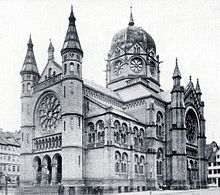
Destroyed in 1938: The New Synagogue in Calenberger Neustadt, opened in 1870
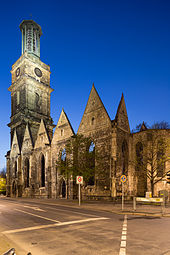
Memorial Aegidienkirche (Location52 .3694229. 73923 )
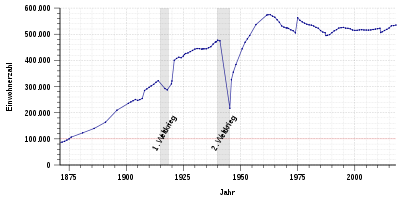
Population development from 1871 to 2017
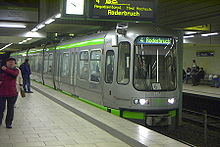
Kröpcke subway station of the Hannover city railroad (location52 .3745099 .738563 )

Completed in 1898, Hubert Stier's river water art survived all 88 air raids on Hanover, but was nevertheless demolished in 1963. Reconstruction has been under consideration since 2008. (Lage52. 3696279.733628 )
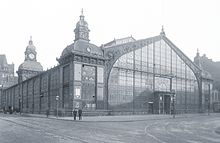
Old market hall from 1892 in the center of Hannover, destroyed in 1943, successor building in 1954

Hanover and Linden 1873

Georgstraße with streetcar around 1895
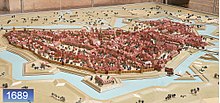
Model of Hanover around 1689 with high extension of the city fortifications
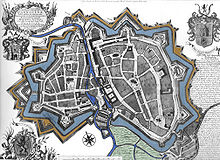
Hannover in 1745 as a star-shaped fortified city with redoubts, bastions and moats. West of the Leine lies the included Calenberger Neustadt.

Hanover seen from the northeast, fortified with moat, rampart and city wall with wall towers; Merian engraving published for the first time in 1641
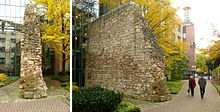
Rest of the city wall Hannover (Lage52 .3698669 .740626 )

Oldest half-timbered house in Hannover from 1566 at Burgstraße 12 (location52 .3730759 .731176 )
Politics
On November 1, 2001, the Hannover Region was formed from the cities and municipalities of the Hannover County and the City of Hannover. Since then, Hannover has been a municipality belonging to the region with the legal status of an independent city.
City Council
City Council Election 2016
Voter turnout: 51.5
%
40
30
20
10
0
31,3
24,5
16,3
8,6
7,0
5,1
2,8
2,1
2,3
SPD
CDU
Green
AfD
Left
FDP
HAN
Pirates
Otherwise.
Gains and losses
compared to 2011
%p
10
8
6
4
2
0
-2
-4
-6
−5,8
−0,7
−5,1
+8,6
+2,7
+2,4
−0,5
−1,4
−0,2
SPD
CDU
Green
AfD
Left
FDP
HAN
Pirates
Otherwise.
The Council is the municipal representation and main body of the City of Hanover and decides on all important self-government matters of the City. It acts as a representative body through resolutions. The citizens decide on the allocation of the 64 seats every five years in a general, direct, free, equal and secret election. The members bear the title of Councilman or Councilwoman of the City of Hanover. Since the 2016 municipal elections, there has been an alliance of SPD, Bündnis 90/Die Grünen and the FDP. The Lord Mayor is a member of the Council by virtue of his office. The council forms specialist committees. The individual parliamentary groups and committees include further advisory members without voting rights who are appointed by the parliamentary groups. The Lord Mayor and the department heads attend the meetings of the Council and its committees and report to the Council. The department heads represent each other. Chairman of the Council is the 1st Mayor of the City of Hanover who is elected from the midst of the Council, since June 19, 2014 Thomas Hermann (SPD) has held the office. He is represented by the other mayors. The council chairman, the other mayors and the members, are honorary. The meetings are transmitted by the citizen television H1.
See also: Results of the local elections in Hannover
Municipal Councils
In addition to the city council as the main body, there have been city district councils in Hanover's 13 municipalities since 1981. They have their own responsibilities, decision-making, consultation and initiative rights. The city district councils ensure the maintenance of public facilities located in their district, promote community life and represent their city district. Borough councils have 19 to 21 members, called borough aldermen or borough alderwomen. The city district councils have the right to be heard in the bodies of the city of Hanover (council, administrative committee, technical committees). They can take the initiative in local politics on their own initiative. Each city district is headed by a district mayor, who is the chairman of the district council and has the right to be heard in the bodies of the city and the council. City district councils are elected every 5 years, most recently in 2016. Members and district mayors serve in an honorary capacity.
Mayor
See also: List of chief administrative officers of Hannover
In 1996, the previous dual leadership of honorary Lord Mayor as the highest representative and Lord Mayor as head of the administration was abandoned in Lower Saxony. Since then, Hannover has had a directly elected full-time mayor. In October 2013, Stefan Schostok (SPD) was elected and inaugurated into the eight-year term. His early retirement took place on May 27, 2019. The by-election for a new Lord Mayor was decided by a run-off between Belit Onay (Bündnis 90/Die Grünen) and Eckhard Scholz (no party, nominated by the CDU) on November 10, 2019. It was won by Belit Onay with 52.9% of the votes. The inauguration took place on November 22, 2019. The Lord Mayor is the head of the city administration and the highest representative of the city.
Mayor
In addition to the Lord Mayor, there are three honorary representatives. They are elected by the council and bear the title of mayor; they preside over the council meetings. Since June 19, 2014, these have been Thomas Hermann (SPD) as the first deputy and, since 2011, Klaus Dieter Scholz (CDU) as the second deputy and Regine Kramarek (Bündnis 90/Die Grünen) as the third deputy to the Lord Mayor.
Management Committee
The Management Committee is the second body of the City, apart from the City Council, to which tasks are assigned for its own decision-making. Its tasks include preparing the resolutions of the Council. It is responsible for and has a quorum on matters which do not require the decision of the Council, the City District Councils or the Works Committees and which are not the responsibility of the Lord Mayor. In certain cases, it may delegate responsibilities to the Lord Mayor. Its members include the Lord Mayor as Chairman, the other mayors, other members of the Council as aldermen and, as advisory members, the department heads/city councilors.
Management
The city administration is the local self-government of the state capital of Hannover and is divided into the area of responsibility of the Lord Mayor as head of the administration and seven departments (since 2020). The department heads bear the designation City Councillor or City Councillor (the City Councillor for Finance also City Treasurer). The general representative of the Lord Mayor in the administration is the First City Councilor; since August 2013, Sabine Tegtmeyer-Dette, City Councillor for Economy and Environment, has held the office. The department heads are elected by the City Council for eight years on the recommendation of the Lord Mayor.
See also: Hannover City Council
Advisory boards
The Seniors' Advisory Council is the official neutral representation of seniors in Hannover. The Eilenriedebeirat was established by the city in 1956, it is the guardian of the city forest and strives for the preservation and maintenance of the Eilenriede and advises the committees of the city.
Coat of arms
The coat of arms of the city of Hanover shows a silver wall with two pewter towers on a red background; in the open gate, under a black portcullis, is a golden shield with a green Mary's flower or shamrock (unexplained); between the towers is a golden lion.
The coat of arms can be traced as early as 1266 as a seal, with Mary's flower/cloverleaf (previously a mint mark) from 1534, whereby the lion is the symbol of the Guelphs or the rule of the Duchy of Brunswick, to whose dominion the city belonged. The city's coat of arms has had its present form since 1929. The old city colors of red, yellow and green were replaced by red and white in 1897.
Town twinning
Hannover is twinned with the following cities:
- United Kingdom
 Bristol (United Kingdom, since 1947)
Bristol (United Kingdom, since 1947) - France
 Perpignan (France, since 1960)
Perpignan (France, since 1960) - France
 Rouen (France, since 1966)
Rouen (France, since 1966) - Malawi
 Blantyre (Malawi, since 1968)
Blantyre (Malawi, since 1968) - Poland
 Poznan (Poland, since 1979)
Poznan (Poland, since 1979) - Japan
 Hiroshima (Japan, since 1983)
Hiroshima (Japan, since 1983) - Germany
 Leipzig (Germany, since 1987, then GDR)
Leipzig (Germany, since 1987, then GDR)
Another town twinning existed between 1971 and 1976 with Utrecht (Netherlands). There is a friendship treaty with Ivanovo (Russia). With the opening of a Hanoverian quarter in the Chinese city, a city friendship exists with Changde. The shopping street there was opened by the mayor. The town twinning of Ahlem, Anderten and Misburg, which began before their incorporation, is continued at the borough level. In the Maschpark, paths are named after the twin towns, earning it the designation "Park of the Twin Towns".

Belit Onay, acting Lord Mayor of Hanover (Photo 2018)
_Thomas_Hermann_(SPD),_Erster_Bürgermeister_der_Landeshauptstadt.jpg)
Thomas Hermann, Mayor and Chairman of the Hannover City Council since 2014
Sights
Buildings
→ Main article: List of architectural monuments in Hanover and List of sacred buildings in Hanover.
The eclectic New City Hall, opened in 1913, is located between the Old Town and Maschpark. The observation deck in the dome can be reached by the uniquely arched dome elevator. In the reception hall of the City Hall are four city models showing the city in 1689, 1939, 1945 and the present. Today, the New Town Hall is considered Hanover's landmark and in 2015 was among the 80 most popular sights in Germany, according to a GNTB online survey of foreign tourists. 36 sights in the city center are connected by the so-called Red Thread. This 4.2-kilometer-long red line painted on the pavement leads through the city center in a circular route starting at the Tourist Information Office on Ernst-August-Platz.
Old Town and North German Brick Gothic
Today's Old Town of Hannover is very different from the original Old Town before the Second World War. Hanover's city center was 90% destroyed, which included the old town. Therefore, a kind of tradition island was created around the Marktkirche. For this purpose, the great landmarks, such as the Marktkirche, were rebuilt, half-timbered houses and other buildings were relocated from other parts of the city, and post-war buildings were created as part of the reconstruction, which fit harmoniously into the old town. The current gate to the old town is the Marstall Gate by Louis Remy de la Fosse. It is the preserved central portal of a riding house of the court stables on the High Bank. In the center of the Old Town, as already mentioned, is the Market Church, built in the 14th century, with the Market Square along with the Market Fountain of Hanover. Together with the Old Town Hall it is a testimony of the North German brick Gothic. In the neighborhood of the market church are the Broyhanhaus, the Hanns-Lilje-Haus and the Georg-von-Cölln-Haus. The Kreuzkirche in the Kreuzkirchenviertel has a valuable altarpiece by Lucas Cranach the Elder; opposite it is the Kreuzklappe restaurant. Burgstrasse 12 is home to Hannover's oldest surviving half-timbered house dating from 1564/1566. The Ballhof, built between 1649 and 1664, was the city's largest event hall for a long time and is now one of the venues of the Lower Saxony State Theater. At the Holzmarkt with the Oskar Winter Fountain, next to the Nolte House built shortly before 1900, stands a house with the Renaissance facade of the war-destroyed Leibniz House (originally built from 1499 on Schmiedestraße), reconstructed in 1983. Of the medieval city defense towers, only the Begin Tower at the Historical Museum has been completely preserved. The old town borders the Hohe Ufer (High Bank) of the Leine River, where the Leineschloss (Leine Castle) and a riverside promenade redesigned in 2018 with cafes and restaurants are located.
· 
The Marstall Gate is today's gate to the Old Town
· 
Cross Church
· 
Leibnizhaus (left), Noltehaus (right) and in front of it the Oskar Winter Fountain
· 
Georg-von-Cölln-Haus
· 
Burgstraße 12 - Hanover's oldest half-timbered house
· 
Begin Tower
·
Old town hall, original wing and Venetian wing
· 
Kramerstrasse
Calenberg New Town
The Martin Neuffer Bridge leads from the old town to the new town of Calenberg. This, too, suffered severe destruction during the Second World War. Nevertheless, there are numerous representative sandstone buildings and churches here. The Baroque Neustadt Church with Leibniz's tomb and the Basilica of St. Clemens, the first new Catholic church to be built in Hanover after the Reformation, as well as the Protestant Reformed Church, whose bells were donated by the British Queen Victoria, still give an idea of why the Calenberger Neustadt was called the "Island of Freedom". Even at that time, all denominations and faiths were allowed. Calenberger Neustadt is also home to the Lower Saxony State Archives and the Ministry of the Environment, and in front of them on the median strip of Leibnizufer is the Duve Fountain.
· 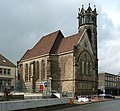
Ev.-ref. church
· 
Nds. main state archive
· 
Duve Fountain
· 
Neustadt church
Laves classicism
Everywhere in the city center, but also in some parts of the city, one encounters buildings by the master builder Georg Ludwig Friedrich Laves. At the beginning of the 19th century, he began planning and designing the Ernst-August-Stadt, today part of the city's Mitte district. Among his greatest buildings in Hanover are the Opera House, the Waterloo Column, the Wangenheim Palace, and the Laveshaus across from the New City Hall. He rebuilt the Leineschloss on the edge of the old town (now the seat of the Lower Saxony state parliament) and extended it with, among other things, the Portikus on Leinstrasse. Other buildings by Laves include the garden house of the chambermaid von Beckedorf, the Villa Rosa and various bridges.
· 
Laveshaus
· 
Wangenheimpalais
· 
Waterloo column
· 
Villa Rosa
· 
Laves Bridge in the Guelph Garden
Hanover School of Architecture
In the mid to late 19th century, the Hanover School of Architecture created its own formal language with clinker brick buildings in the neo-Gothic and round arch styles (for example, with the Künstlerhaus Hannover, 1855), which had an impact beyond Hanover and shaped the face of the large tenement house quarters.
· 
Former stables at the Welfenschloss
· 
Dat Gröne Hus
· 
Old town hall, wing facing Karmarschstraße
· 
Trinity Church
Brick expressionism
Brick Expressionism in Hanover in the 1920s and 1930s is represented above all by Fritz Höger's Anzeiger high-rise at Steintor, the building of the Hanover City Library on Hildesheimer Strasse and the Capitol high-rise at Schwarzer Bären in Linden. Numerous residential buildings of the same architectural style can also be found in Südstadt, List, Kleefeld and Ricklingen.
· 
Capitol skyscraper
· 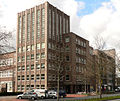
Hanover City Library
· 
Garden City Kleefeld
Art Nouveau
Many buildings and neighborhoods in Hanover are characterized by Art Nouveau, including the district of Linden with Lichtenbergplatz or the Oststadt with Bödeckerstraße, also known as Hanover's boulevard. Other districts with numerous Art Nouveau buildings include Döhren, List, Kleefeld and the Nordstadt and Südstadt.
· 
Lichtenbergplatz
· 
Bödeckerstrasse
Other historical buildings
Not far from the opera house is the banking district with the Hanover Stock Exchange (built in the Tudor style), the Palais Grote, the Hansa House and many other large and representative sandstone buildings.
In 1914, the neoclassical Stadthalle with its domed hall was opened. The building of the Goseriede Baths, built in 1905, now houses the Kestnergesellschaft and the headquarters of the radio station Radio ffn. The central section, destroyed in World War II, was replaced by a new building. Across the street on the Goseriede is the Tiedthof, an example of the revitalization of old buildings.
There are three historic windmills in Hannover. In Hermann-Löns-Park there is a Bockwindmühle from 1701; in addition there are two Dutch windmills built in the 19th century: the Buchholz windmill was erected in 1868, the Anderter windmill dates from 1854.
· 
Grote Palace
· 
Hansa House
· _IMG_1687.jpg)
Bock windmill in Hermann Löns Park
· _IMG_7569.jpg)
Anderter mill
· 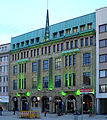
Tiedthof Hanover
Sacred buildings
In addition to the churches in the Old Town and the New Town of Calenberg, there are numerous other historic as well as modern church buildings in the city area. The oldest existing church in Hanover in the Marienwerder monastery was built with three naves around 1200 in the Romanesque style. The Garden Church of St. Mary in Marienstraße, the Christ Church on Klagesmarkt, the Luther Church in Nordstadt and the Church of the Redeemer in Linden-Süd are considered to be neo-Gothic. St. Elisabeth's Church in the Zoo district has a particularly elaborate interior design. The Aegidienkirche and the Nikolaikapelle remained in ruins after World War II and serve as memorials.
· _IMG_3206.jpg)
Marienwerder Monastery
· 
Garden Church of St. Mary
·
Christ Church
· 
Luther Church
·
Ruin of the Nikolai Chapel
Towers
There is a whole series of towers in Hanover. In addition to the numerous church towers, there are still some towers of the Hanoverian Landwehr with the Döhrener Turm, the Pferdeturm and the Turm auf dem Lindener Berg. The Borgentrick Tower opposite the New Town Hall has only been preserved in rudiments and the Lister Tower, which was demolished in the middle of the 19th century, was replaced by a romanticized replica in 1895.
The Telemax in Groß-Buchholz is the highest radio tower in Lower Saxony. The old TV tower at the main station, called Telemoritz, now serves advertising purposes as the VW Tower.
·
Horse Tower
· _IMG_9791.jpg)
Lister Tower with half-timbered castle
·
VW Tower
Modern buildings
Dieter Oesterlen had a major influence on the architecture of the post-war period, which was shaped by the ideas of city architect Rudolf Hillebrecht, with buildings such as the Historical Museum and the NDR broadcasting center on the Maschsee. He designed the new building of the Church of St. Martin in Linden-Mitte, of which only the tower had survived the Second World War.
In the 1970s, Brutalism left its mark on the city with buildings such as the Kröpcke Center (now completely redesigned), the Bredero high-rise and the Ihme Center.
Examples of contemporary architecture include the 83.52-meter-high glass administration building of Nord/LB at Aegidientorplatz and the glass gatehouse at Aegi, the deconstructivist Gehry Tower by architect Frank Gehry and the media center by Alessandro Mendini. On the outskirts of the city at Kronsberg lies the Expo Park Hannover industrial park. Several exhibition pavilions and the extensive Expo Plaza have been preserved from Expo 2000.
The Hanover-Marienwerder wind turbine, erected in 2012, was the first modern wind turbine to be built on a wooden tower.
· 
Kröpcke Center
· 
Gehry Tower
· 
Media center in the Mendini House
· 
Gatehouse at the Aegi
· 
Expowal at Expo Park Hanover
Monuments, memorials and street art
The Leibniz Temple in the Georgengarten is a pavilion building erected from 1787 to 1790 in honor of the polymath Gottfried Wilhelm Leibniz, who worked in Hanover - originally at Waterlooplatz. It is considered the first public monument in Germany to a non-aristocrat.
The Waterloo Column, also neoclassical, is a 46.31-meter-high victory column on Waterlooplatz in the Calenberger Neustadt district. It was erected between 1825 and 1832 to a design by Georg Ludwig Laves.
The Reese Fountain, a majolica plant sculpture created in 1925 by Martha and Hans Poelzig, stands on Fritz-Behrens-Allee near the Hochschule für Musik, Theater und Medien on the edge of Eilenriede. It is a rare example of a fountain in the Art Deco style. Another fountain by Hans Poelzig can be found in the Großer Garten in Dresden.
In the 1970s, the city launched an ambitious program of street art in Hanover as art in public space on the initiative of the then chief city director Martin Neuffer. The best-known objects, which were extremely controversial at the time, were the Nanas by Niki de Saint Phalle on Leibnizufer, erected in 1974. In the course of time, the Sculpture Mile was created between the banks of the Leine and Königsworther Platz with seven other objects along a length of 1.2 km. Today, Hannover occupies a top position in Germany with more than 200 sculptures, sculptures and installations in the urban space.
In the 1990s, the BUSSTOPS project created nine bus and light rail stops designed by international designers. These are located, for example, at Steintor (designer Alessandro Mendini), Königsworther Platz (Ettore Sottsass), Maschsee/Sprengel Museum (Heike Mühlhaus) and Braunschweiger Platz (Frank O. Gehry).
Near the Lower Saxony Parliament is the sculpture group of the Göttingen Seven, which commemorates the protest of seven Göttingen professors against the abolition of the Hanoverian state constitution by King Ernst August I in 1837, in whose honor the Ernst August Monument was erected in front of the main train station in 1861. A popular meeting place is the Kröpcke clock in the city center.
The Jewish Memorial in Calenberger Neustadt commemorates the 350 Jews who were deported to Riga and Theresienburg in 1941/42. In the Rote Reihe is the memorial to the synagogue destroyed in the Reichspogromnacht and in the Georgstraße is the memorial to the murdered Jews of Hanover.
The largest memorial in the city is the ruin of the Aegidienkirche. It serves as a memorial to the victims from wars and violence. Inside is the Peace Bell, a donation from the twin city of Hiroshima, and on the church tower is a carillon.
See also: List of monuments in Hannover
Green spaces and local recreation
→ Main article: List of parks in Hannover
Animal parks
→ Main article: Hanover Zoo
Hannover Adventure Zoo was opened in 1865 as "Zoo Hannover" and is thus one of the five oldest zoos in Germany. The development into an adventure zoo began in the mid-1990s. Today, there are several themed areas with different landscapes called Zambezi (with boat ride and petting meadow), Jungle Palace, Afi Mountain (with jungle house and bird aviary), Meyers Hof, Outback, Mullewapp (with three summer toboggan runs) and Yukon Bay (with underwater world). They are designed to introduce visitors to the animals of the world in the most authentic and at the same time species-appropriate environment possible. Furthermore, there is the small themed area Himalaya, the Tropical House, the adventure playground Brodelburg and daily about 20 commented animal feedings and animal performances in the Show Arena and Yukon Stadium. From 2018 to 2020, the zoo also featured Yadegar Asisi's Amazonia panorama. 2159 animals in 181 species, which have an area of about 22 hectares at their disposal, attract more than one million visitors annually. The Adventure Zoo has won several awards, including the Parkscout Audience Award as Germany's best zoo seven times (most recently in 2017).
The zoo in the Kirchrode district, formerly a princely hunting ground, was opened to the public in 1799 and houses 150-200 native animals and numerous plant species on 112 hectares. There is a bird aviary and large enclosures for red deer and wild boar. The fallow deer can move freely throughout the zoo. At the entrance there is a playground and the 1000-year-old oak tree.
Herrenhäuser Gardens
→ Main article: Herrenhäuser Gardens
One of the most famous Hanoverian sights is the Herrenhäuser Gardens. The Great Garden is an important European baroque garden. Besides numerous special gardens, the Great Parterre, the Orange Parterre, the Maze and the Nouveau Jardin are the most famous parts of the Great Garden. The Great Fountain there reaches an apex height of up to 71.51 meters, making it the highest garden fountain in Europe. The Great Garden also includes the Grotto, whose interiors were designed by Niki de Saint-Phalle, the two corner pavilions by Louis Remy de la Fosse, the historic Garden Theater, as well as the Gallery Building with the Golden Gate, the Orangery and the Arne Jacobsen Foyer. Herrenhausen Palace, destroyed during World War II, was reconstructed starting in 2011 and reopened on January 18, 2013. Not far from the Great Garden stand the Prince's House and the Hardenberg House. The Berggarten is one of the oldest botanical gardens in Germany with about 12,000 plant species. There is the Tropical Show House, the Cactus Show Houses, the Orchid Show House with one of the largest orchid collections in Europe and the Canary House. In addition to numerous themed gardens, there is also Germany's oldest prairie garden, the Schmuckhof, and the Staudengrund, one of the oldest gardens of its kind in Europe. In 2007, the Sea Life Centre opened with more than 3,500 tropical freshwater and saltwater fish. Among other things, there is an approximately 8-meter-long glass tunnel through the deep-sea basin and a replica of the tropical rainforest. Furthermore, the Guelph mausoleum and the library pavilion are located in the Berggarten. The Georgengarten is laid out in the style of an English landscape park. It contains the almost two-kilometer-long Herrenhäuser Allee, the Leibniz Temple and the Georgenpalais. In the Guelph Garden is the Guelph Palace - today the main building of the university - and in front of it as a sculpture the Lower Saxony Horse, the heraldic animal of Lower Saxony. In 2015, the Herrenhäuser Gardens became the first garden in Germany to be named Best Park in Europe by the European Garden Heritage Network. In 2018, the Herrenhäuser Gardens were visited by around 615,000 guests from around 100 countries. In 2019, the gardens became the first garden in Germany to join the European Network of Historic Gardens (ERHG), and since 2020, the Herrenhäuser Gardens have been part of the European Route of Historic Gardens, a cultural route of the Council of Europe.
Urban forests and parks
Hannover is considered one of the greenest major cities in Germany because of its many inner-city green spaces and advertises itself as a "green metropolis". It came first in Germany in a 2011 ranking by Meinestadt.de, but not in others, since other cities have more green spaces by area (total or proportionate) and some rankings do not count only public green spaces. However, Hannover is considered particularly sustainable in its urban development.
The Eilenriede, a 650-hectare city forest, is known as the city's "green lung". It is home to the environmental education facility Waldstation Eilenriede (with an observation tower), two trim trails, a tree nature trail, eight sunbathing lawns, 14 monuments, ten playgrounds and the WAKITU play park with a high ropes course. The network of paths in the Eilenriede consists of 80 km of hiking trails, 38 km of bike paths and 11 km of bridle paths.
Other city forests include the Seelhorst in the south of the Eilenriede, the Große Heide in Bothfeld, the Misburger Wald, the Gaim and the Bockmerholz in Wülferode, the Wettberger Holz, the Bornumer Holz in Badenstedt, the Klosterforst in Marienwerder, the Mecklenheide in the Nordhafen district, the Gemeindeholz in Stöcken and the Spannriede in Ledeburg.
The historic municipal parks include the Stadtpark next to the Stadthalle with the Rosarium and the Japanese Tea Garden, the Hermann-Löns-Park in Kleefeld, the Maschpark at the New City Hall and the Hinübersche Garten near the Marienwerder Monastery. The district parks include the Alte Bult with the Hiroshima Grove, the Vahrenwalder Park, which was created in 1986 as a district park on the site of the former Royal Riding Hall, with herbaceous plants, meadow area and fountains, the Botanical School Garden in the Burg district and the Von Alten Garden in Linden-Mitte with relics (gatehouses, garden terrace) of the von Alten family's castle, which was destroyed in 1945.
The new gardens include Willy-Spahn-Park in Ahlem and the Expo Gardens, which were created as part of the Expo 2000 world exhibition. They consist of the Gardens in Transition, designed by landscape architect Kamel Louafi, Expo Park South and Parc Agricole. The gardens connect with the landscape space of the Kronsberg district, newly created for the World Expo. Kamel Louafi redesigned part of Opera Square from 2008 to 2010.
Other recreational areas close to the city are the riverside promenades and green spaces along the Leine, Ihme and Mittellandkanal. The new construction of the Benno-Ohnesorg bridge and flood protection measures on the Ihme are redesigning the banks of the Ihme in Calenberger Neustadt.
See also: List of parks in Hannover
See also: Floods in Hanover
Lakes and swimming pools
The man-made 78-hectare Maschsee is located south of the city center within sight of the New City Hall. The lake, which was opened in May 1936 after two years of construction, is the city's largest body of water. It has no natural inflow or outflow and is supplied with water from the nearby Ricklinger gravel ponds via a pumping station. Rowing and sailing is possible on the lake via two sailing schools and several clubs. During the summer months, üstra operates passenger boats on a circular route with four ships. Swimming in the lake is possible at the lido on the south shore. According to a ranking by the travel portal holidu in 2020, Maschsee is one of the most popular lakes in Germany (9th out of 3,070). Other lakes with outdoor swimming opportunities are Altwarmbüchener See and Sonnensee in Misburg as well as the Ricklinger Kiesteiche.
There are five indoor swimming pools in the city: Stadionbad, Vahrenwalder Bad, Nord-Ost-Bad, Stöckener Bad and Anderter Bad. In addition, there are the Fössebad in Limmer and the Misburger Bad as indoor outdoor pools.
Six outdoor pools are open from May to September: Lister Bad, Hainhölzer Naturbad, Ricklinger Bad, RSV-Bad Leinhausen, Volksbad Limmer and Kleefelder Bad (Annabad) in Hermann-Löns-Park.
Cemeteries
Hannover's large cemeteries include the city cemetery Engesohde as the oldest cemetery with many mausoleums and sculptured grave monuments, the city cemetery Ricklingen, the city cemetery Seelhorst (with 63 hectares the largest), the city cemetery Stöcken and the 1968 created and thus youngest city cemetery Lahe. The Garden Cemetery, the St. Nikolai Cemetery (where the ruins of the Nikolai Chapel, one of the oldest buildings in the city, are located), the Neustadt Cemetery, the Old Jewish Cemetery on Oberstrasse and the Jewish Cemetery on Strangriede are disused and serve as parks. The same applies to the Lindener Bergfriedhof, which offers a botanical speciality in spring; here the bright-blue Scilla blossom blooms over the whole area as the blue wonder of Linden.
Green ring
On the Green Ring, a circular hiking and biking trail established since 1995, you can circle the city of Hannover along the city limits. The Green Ring consists of a base ring 80 kilometers long as well as three surrounding loops and two inner loops. The basic ring leads through peripheral districts as well as nearby surrounding communities and satellite towns.

enlarge and show information about the image
![]()
Panoramic view from the observation deck in the New Town Hall

Main Hall New City Hall

Marktkirche (Lage52. 3717999.735231 )

Basilica of St. Clement
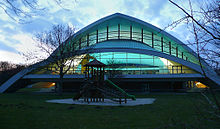
Stadionbad (Lage52. 3592449.734009 )
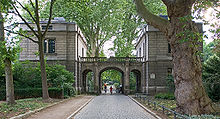
Von-Alten-Garten (Lage52. 3647529.714349 )
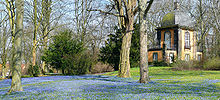
Scilla flowers at the Linden mountain cemetery (location52 .3627399 .703387 )
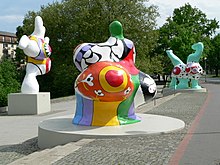
Nanas on the banks of the river Leine (Lage52 .3721959. 729951 )
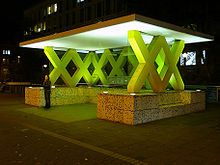
BUSSTOPS stop

Administration building of the Nord/LB (Location52 .3675379 .741474 )
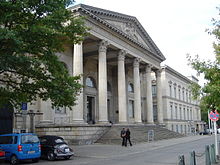
Leineschloss, Parliament of Lower Saxony (Lage52 .3705079 .733218 )
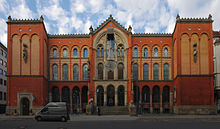
Künstlerhaus (Lage52. 3727939.743211 )

Hanover stock exchange
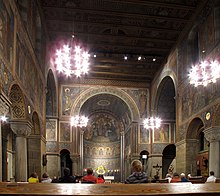
St. Elisabeth Church
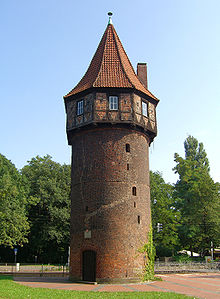
Doehren Tower

Scoreboard high-rise

Boat trip in the "Zambezi" themed area at Hannover Adventure Zoo
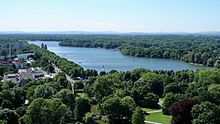
Maschsee (Lage52. 3569969.741166 )
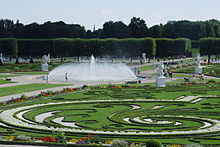
Large parterre with fountain in the Great Garden (location52 .3897189 .697228 )
Economy and infrastructure
Key figures
In 2017, the city generated a total gross domestic product at market prices of 34,100.9 million euros, equivalent to 80,228 euros per employed person. In 2012, the gross value added at production cost was 30,743.8 million euros, equivalent to 72,330 euros per employed person.
Around 300,000 employees subject to social insurance contributions worked in the city in 2014. Of these, around 189,000 had their primary residence in Hannover. While 54,285 commuters leave the city, 164,892 commuters arrive in the city every day. This results in a commuter balance of around 111,000.
The purchasing power per inhabitant in Hannover was 21,948 euros in 2014. In the same period, retail sales amounted to 6,960 euros per inhabitant, while retail purchasing power was 5,931.00 euros per inhabitant, which indicates positive shopping tourism to the city. In 2015, the purchasing power per inhabitant increased to 22,071 euros, with a retail purchasing power of 5,932 euros per inhabitant and a retail turnover of 6,714 euros per inhabitant.
In 2015, the total retail turnover has a value of 3,793.4 million euros, which means 7,236 euros per capita, with a retail purchasing power of 6,745 euros per inhabitant.
At the beginning of 2014, the city was home to a total of 34,198 businesses (members of the Hannover Chamber of Commerce and Industry), excluding the 3,633 dependent business establishments, of which 9,342 were registered in the commercial register and 24,856 were small businesses. This means that the city of Hannover is home to more than half of all businesses in Hannover Region that are registered in the commercial register (total: 17,485) and half of all businesses in Hannover Region that are not registered there (total: 49,081). The city is also home to 5,110 craft businesses with 30,759 employees and sales of 2.05 billion euros in 2015.
The largest employers in Hannover include:
- Volkswagen Commercial Vehicles, 15,000 employees
- Hannover Region Hospital (KRH), 8,500 employees
- Continental, 7,800 employees
- Hannover Medical School (MHH), 7,600 employees
- Nord/LB with Deutsche Hypothekenbank, 4,000 employees
- Sparkasse Hannover incl. subsidiaries, 2,900 employees
- VHV Versicherungen, 2,600 employees at the Hanover site
- Talanx, 2,500 employees
- WABCO, 2,500 employees
In the Hannover Region, Deutsche Bahn employs around 5,500 people and Deutsche Post DHL around 4,400.
Industry
Various industrial companies are based in Hanover, including the automotive supplier and DAX-listed corporation Continental AG, Volkswagen Commercial Vehicles, the vehicle systems manufacturer WABCO, the construction machinery manufacturer Komatsu Hanomag, the Johnson Controls plant for starter batteries (formerly VARTA), the tourism group TUI and the abrasives manufacturer VSM Vereinigte Schmirgel- und Maschinen-Fabriken. The food industry is represented by Bahlsen, Harry-Brot and the breweries Gilde Brauerei and Herrenhäuser Brauerei. The cement industry near Hanover, which was established at the end of the 19th century, is the focus of Lower Saxony's cement production. It is centered in the Misburg-Süd district and neighboring towns.
Hannover used to be home to other well-known companies, such as the Preussag coal and steel company, the Hanomag vehicle manufacturer, the Sprengel chocolate manufacturer (taken over by Stollwerck in 1979, closed in 2001), the Pelikan and Geha stationery manufacturers, the Deurag-Nerag oil refinery (closed in 1986) and the Deutsche Grammophon record factory (part of Polygram from 1971), closed since 1990. The last headquarters of the mineral oil company and service station operator Gasolin was also located in Hanover until 1971. In addition, there was PreussenElektra, founded in 1923 and for a time the second largest energy supply company in Germany, which merged with Bayernwerk in 2000 to form E.ON. It has since been reestablished as PreussenElektra GmbH and is responsible for dismantling nuclear power plants belonging to E.ON Kernkraft GmbH. In 1879, the Appel Feinkost company was founded.
Services
Hannover's service companies include a number of banks, financial service providers and insurance companies such as Norddeutsche Landesbank (NORD/LB), Sparkasse Hannover, Hannoversche Volksbank, ING-DiBa, Bankhaus Hallbaum, Swiss Life Select, VHV, Kaufmännische Krankenkasse - KKH, LBS, Mecklenburgische Versicherungsgruppe, Hannover Rück, Hannoversche, HDI Versicherungen and Talanx. In addition, there is the tourism group TUI with its subsidiaries TUI Deutschland, 1-2-Fly and Robinson. Stadtwerke Hannover supplies Hannover and the surrounding area with electricity, gas, water and district heating. Other energy service companies include BEB, Gasunie Deutschland, E.ON Energie AG and ExxonMobil. The new economy is represented, for example, by the Internet tire dealer Delticom. The Hanover Stock Exchange was founded in 1785.
The Siemens company had several locations in Hannover. In 1988, Siemens moved to Hildesheimer Straße in Alt-Laatzen. Founded in 2003, hannoverimpuls is the joint economic development company of the city and region of Hannover. It supports the foundation, settlement and growth of companies in the business location Hannover.
Retail
Hannover is a retail center whose catchment area extends into the Ostwestfalen-Lippe region. The sales area in the city of Hannover is around 885,000 square meters, of which 285,000 square meters are in the city center. The inner-city pedestrian zone comprises several streets around the Kröpcke. In frequency counts, Georgstraße ranked third in 2019 and Bahnhofstraße ranked eleventh in 2018 (for technical reasons, Bahnhofstraße was not counted in 2019) among the most popular shopping streets in Germany. Große Packhofstraße ranked 16th and Karmarschstraße 18th in 2019. Downtown shopping arcades include Hamburg-based ECE Projektmanagement's Ernst-August-Galerie, which opened next to the main train station in 2008, Niki-de-Saint-Phalle-Promenade, "Einkaufsbahnhof Hannover," Kaufland Einkaufszentrum, Kröpcke-Passage, and Galerie Luise with Langensche Höfe. With about 300 kiosks (also called Trinkhalle in Hannover), Hannover has one of the highest kiosk densities in Germany, some of which are listed. Major shopping streets outside the city center include the Lister Meile, Limmerstrasse and Engelbosteler Damm. Small to medium-sized shopping centers have sprung up in many parts of the city, including the Klein-Buchholz shopping park.
Tourism
There are 111 lodging establishments in Hannover, including 45 hotels, 46 garni hotels, 6 inns, and 14 other lodging establishments (as of 2019). In total, the establishments have 14,149 beds. Of the 111 establishments, 56 are certified, so there is 1 five-star, 25 four-star, 23 three-star, 6 two-star and one one-star hotel. In 2019, the city recorded over 2.3 million overnight stays (1.2 million in 2001, 1.6 million in 2006, 2.1 million in 2011). A small RV park is located not far from the Herrenhäuser Gardens. In addition, Hanover has a tradition of "fair moms." This tradition dates back to the decision of the British occupation forces to host an export fair in Hannover starting in 1947. Because of the difficult accommodation situation in the largely bombed-out city, it had called on the population to accommodate trade fair guests in their homes. Today, hundreds of people make their private living space (private rooms, vacation apartments and houses) available in Hanover through various accommodation agencies, to a large extent also outside the trade fair periods. However, these accommodations are not taken into account in the official overnight stay statistics, according to a study by dwif-Consulting, however, these accommodations account for about 0.3 million overnight stays per year. The most important foreign market for Hannover is Great Britain (approx. 43,000 overnight stays), followed by the Netherlands (approx. 29,000), the USA (approx. 28,000), Russia (approx. 23,000), Poland (approx. 22,000) and Switzerland and Italy (approx. 20,000 each). In addition, according to a basic study by dwif-Consulting, Hannover has 41 million day visitors per year. With a gross turnover of around 2 billion euros, tourism is one of the most important economic factors for Hannover. As a guideline, it can be said that over 37,000 people in Hannover earn their living from tourism.
The city has a relatively large amount of open and green space, which is why some reporters attribute to it low "density stress" and relaxedness in everyday life. In 2021, Hannover ranked first in Germany and ninth in the world among the most relaxed cities in the world. In 2018, booking portal Booking.com listed Hannover among its ten up-and-coming destinations because of its "many museums, parks and cultural events." The prestigious Location Award was presented five times to Hannover establishments, including twice to Herrenhausen Palace, which reopened after reconstruction in 2013.
The Leine-Heide long-distance cycle route, the Kulturroute cycle route, the Grüner Ring circular cycle and hiking route, the Lower Saxony Mill Road, the Via Scandinavica pilgrimage route and the European Route of Historic Gardens, a Council of Europe cultural route are all important tourist routes that run directly through Hannover.
Public facilities
Hanover is the seat of the Lower Saxony state government and the Lower Saxony state parliament. It is also home to the headquarters of the Bremen and Lower Saxony branch of the Federal Agency for Technical Relief (THW), the Lower Saxony command of the German Armed Forces, and the Lower Saxony State Criminal Police Office. Two federal authorities have their headquarters in Hanover, the Federal Institute for Geosciences and Natural Resources and the Federal Plant Varieties Office. In addition, the Federal Highway Authority has one of its four locations in the city. The Hanover Police Department is responsible for the city and the Hanover region. The Deutsche Bundesbank has its headquarters in Hannover, serving Bremen, Lower Saxony and Saxony-Anhalt. The Social Insurance for Agriculture, Forestry and Horticulture (SVLFG) has an office in Hannover.
Fairs and congresses
Hanover has been a trade fair city since 1947. Today, the Hannover exhibition center is the largest exhibition center in the world. It is operated by Deutsche Messe AG. Around 60 trade fairs and trade events are held here every year, which are visited by over 1 million people annually. The world's leading trade fairs include the Hannover Messe in the spring as well as Interschutz, Domotex, EuroBLECH, Agritechnica, LIGNA, EuroTier, IAA Commercial Vehicles and, alternating with Milan, EMO and, alternating with Stuttgart and Cologne, Didacta. Europe's leading trade fairs include eroFame, Pferd & Jagd, Labvolution, Tire Technology Expo, IdeenExpo and, alternating with Nuremberg in each case, Altenpflege and EUHA Kongress & Ausstellung. Leading national trade fairs are Infa, the German Young Poultry Show and, alternating with Munich, the bpt Congress & Trade Fair. Other trade shows include the ABF, the B.I.G. , the Merchantday, the Micromobility EXPO, the tuning fair Performance & Style Days, the dog & Co. and the bio north. The Supreme Heimtiermesse and Cosmetica are held in Hannover as well as in various other German cities. Annual conventions include the Robotics Congress. In 2000, Hannover hosted the Expo 2000 world exhibition, which attracted around 18 million visitors, far fewer than expected, but is still the most visited event in Germany. Hannover also hosted the ILA from 1957 to 1990. CEBIT was held from 1986 to 2018 and was the world's largest computer trade show for many years. Following the demise of CEBIT, four new events were launched in the form of Twenty2X, CMM, TECHTIDE and P1NG Germany - eSports Interactive Convention, each covering individual subsectors of the computer and digital sectors.
The Hannover Congress Centrum (HCC), which opened in 1914, hosts around 1,000 events a year with around 400,000 visitors, including numerous congresses and also smaller trade fairs (including, among others, the Maker Faire Hannover and the Hannoversche Edelsteintage).
Numerous other trade fairs and congresses are held neither on the exhibition grounds nor in the HCC. These include the traditional art and antiques fair in the gallery building in the Herrenhäuser Gardens, which has already had many organizers and names in recent decades.
The event management platform Cvent has ranked Hannover among the top 25 meeting cities in Europe since 2015.
Media
Radio and film
NDR's state broadcasting center is located on the Maschsee lake, where the regional magazines Hallo Niedersachsen and Niedersachsen 18.00, the travel magazines Nordtour and Nordseereport and, since 2011, the 9:45 p.m. edition of NDR Info (previously: NDR Aktuell) are produced, among others. From 2006 to 2020, NDR also recorded a talk show in Hanover, initially in the Royal Riding Hall, then from 2008 in the NDR studio on the exhibition grounds. The talk show has had various names over the years: "Herman and Tietjen" (2006-2007), Talk mit Tietjen (2007), Die Tietjen und Dibaba (2008-2009), Tietjen und Hirschhausen (2009-2014), "Bettina und Bommes" (2015-2017), "Tietjen und Bommes" (2017-2019) and "NDR Talk Show" (2019-2020). Also located at the Maschsee is the "Landesstudio Niedersachsen" of ZDF. In four TV studios, the TVN Group produces, among other things, the NDR game show BINGO! and the Sat.1 regional magazine 17:30 live. RTL Nord and Sat.1 Norddeutschland operate regional studios in the Anzeiger high-rise building. TV+ Fernsehproduktion produces television programs for NDR, AZ Media for RTL and n-tv. The ARD.ZDF medienakademie operates one of the two German training centers in Hanover. The TV shopping channel Channel 21 (formerly RTL Shop) is also based here. There is also the non-commercial citizens' television station h-eins. X-City-Medien produces passenger television in several German cities. Hanover is and has also regularly hosted major television entertainment shows, for example Einer wird gewinnen has been a guest at least seventeen times, Wetten, dass..? has been on eight times, The Dome four times, Melodien für Millionen and Willkommen bei Carmen Nebel three times each, Musik ist Trumpf and the Starparade twice each, and Musikantenstadl and Show & Co. mit Carlo once each. Several segments for Verstehen Sie Spaß? were also filmed in Hannover, as well as an episode of the ZDF series Das Literarische Quartett in 2000. In addition, the shows Der goldene Schuß, Zum Blauen Bock, 1:0 für Sie, Nase vorn, Das aktuelle Sportstudio and the ARD Wunschkonzert also made guest appearances in Hanover. Other TV shows that are or were regular guests in Hannover include Jux und Dallerei, Quiz Taxi, Shopping Queen and Das perfekte Dinner. The talk show Tacheles - Talk am roten Tisch was recorded in the Marktkirche from 1999 to 2006 and from 2009 to 2014. In 2010, the multi-part NDR variety show Die Thomas & Helga Show was recorded in the Werkhof.
The PAL color television system introduced in West Germany and West Berlin in August 1967 was developed at Telefunken in Hanover under the leadership of Walter Bruch and introduced there in early 1963.
Film funding is provided by Nordmedia Niedersachsen/Bremen. More than 200 cinema and television films have already been shot in Hannover (as of 2021). Among the best-known productions is Tatort, including some scenes from the first episode Taxi nach Leipzig; from 1974 to 1977, Heinz Brammer (Knut Hinz), and from 2002 to 2017 Charlotte Lindholm investigated in and around Hanover. The Tatort team Falke and Grosz also investigated in Hanover in 2016. Two films in the crime series Stahlnetz were shot in Hanover in 1962 and 1999, as was the first season of the children's series Hallo Spencer in 1979 and the NDR comedy series Big Dating in 2020. In addition, all 626 animated episodes of the series Frühstück bei Stefanie were produced in Hannover. Since 2015, the animated series Freese 1 an alle, a spin-off of the radio comedy series Wir sind die Freeses, has been produced in Hannover. TV films shot in Hannover include Der Mann, der alles kann (2012), Mein alter Freund Fritz (2007), Familie verpflichtet (2015) and Willi und die Windzors (1996), while feature films include 23 - Nichts ist so wie es scheint (1998), Yella (2007), Playground: Love (2013) and The Surprise (2014). Parts of the four-parter Der große Bellheim (1992) and the three-parter Alle Jahre wieder - Die Familie Semmeling (1976) were also filmed in Hanover. The silent film Das Gesicht einer Stadt (The Face of a City), shot in Hanover in 1932, was also shown on overseas steamships (for this purpose, the film was subtitled in English and Spanish). The company Ambient Entertainment produces animated films for the cinema in Hanover, for example Back to Gaya (2004), Urmel aus dem Eis (2006) and Konferenz der Tiere.
Major radio stations in Hanover are NDR 1 Niedersachsen, Hit-Radio Antenne and Radio ffn. At the latter, Oliver Kalkofe, Oliver Welke and Dietmar Wischmeyer, among others, started their careers with Frühstyxradio. There is also the private local station Radio Hannover and the non-commercial local radio station Radio Flora, which has only been broadcasting as an Internet radio station since April 2009.
Press
The daily newspapers Hannoversche Allgemeine Zeitung and Neue Presse, which are published in Hannover, are published by Verlagsgesellschaft Madsack. There is also a local edition of the Bild newspaper. The Deutsche Presse-Agentur (dpa) operates a regional service office in Hanover. Heise-Verlag, Vincentz-Verlag and Schlütersche Verlagsgesellschaft distribute trade magazines and telephone directories. Likewise, the T3N magazine of the Yeebase publishing house is based in Hanover. Rudolf Augstein founded Der Spiegel magazine in Hanover in 1947, and the following year Henri Nannen founded Stern magazine in Hanover.
See also: Hannover-Journal and Hannoversche Tagesnachrichten
Universities
Gottfried Wilhelm Leibniz Universität Hannover in the northern part of the city traces its origins to the Höhere Gewerbeschule, which opened in 1831 and developed into the Königlich-Technische Hochschule, which was elevated to the status of Technische Hochschule in 1899. After the Second World War, the Hochschule für Gartenbau und Landeskultur was incorporated and in 1968 the Pädagogische Hochschule Hannover.
Hannover Medical School (MHH) was founded in 1965. The organizational structure of the MHH deviates from that of a classical university and is based on the department structure of American universities. The individual departments of the MHH have been assigned to centers, which in turn are grouped into four sections (Preclinical Subjects, Large Clinical Subjects, Small Clinical Subjects, Clinical-Theoretical Subjects). The MHH collaborates with the neuroscience research institute International Neuroscience Institute founded by Professor Madjid Samii.
The University of Veterinary Medicine Hannover was opened in 1778 as the Royal Roß-Arzney School and was elevated to a university in 1887. It is the oldest university in Hannover and today participates in the Initiative Wissenschaft Hannover.
The Hanover University of Music, Drama and Media has its origins in the Landesmusikschule and the private Hannoversche Schauspielschule, both of which together were granted the status of an artistic and academic university in 1978. The university also includes the Institute for Journalism and Communication Research and the European Center for Jewish Music in the Villa Seligmann. Famous graduates include Ulrike Folkerts and Katja Riemann.
Hannover University of Applied Sciences and Arts (until 2010 Hannover University of Applied Sciences and Arts) grew out of various institutions, including the Werkkunstschule, the Ingenieurakademie and the Staatliche Baugewerkschule Nienburg. In 1978, the Department of Information and Communications was added. The university is divided into five faculties: Faculty I (Electrical Engineering and Information Technology), Faculty II (Mechanical Engineering and Bioprocess Engineering), Faculty III (Media, Information and Design), Faculty IV (Business and Computer Science) and Faculty V (Deaconry, Health and Social Services). The latter emerged from the Protestant University of Applied Sciences, which was incorporated into the former University of Applied Sciences in 2007.
Other universities include the University of Applied Sciences for Business, the Municipal University of Applied Sciences for Administration in Lower Saxony, the FOM - University of Applied Sciences for Economics and Management, the GISMA Business School, the Leibniz University of Applied Sciences at the Expo Plaza and the University of Applied Sciences for SMEs.
Other business-related educational institutions include the Leibniz Academy and the Europa Fachakademie Dr. Buhmann.
Libraries and archives
The Gottfried Wilhelm Leibniz Library is the state library of Lower Saxony and also a scientific library with a large exhibition and cultural program. It is the former Royal Library with an important old collection of ancient prints and manuscripts dating back to 800 AD. Leibniz's estate is located here. His letters, which have been part of UNESCO's Memory of the World program since 2007, are kept here, as are the Golden Letter (a UNESCO World Document Heritage Site since 2015) and parts of the Monseer Fragments.
The Hannover City Library was first mentioned in a document in 1440. In addition to the central library on Hildesheimer Straße, it has 17 district libraries and a mobile library.
The German National Library of Science and Technology (TIB) is Germany's central specialist library for technology and the natural sciences. With its specialist libraries, it also fulfills the role of university library for Gottfried Wilhelm Leibniz Universität Hannover.
Other important libraries are located at the Hannover Medical School, the University of Veterinary Medicine, the Hannover University of Applied Sciences, and at the Landeskirchenamt Hannover.
Hanover is home to several archives, including the Lower Saxony State Archive, the Hanover City Archive, the State Church Archive of the Evangelical Lutheran Church of Hanover, the Hanover University Archive, the Leibniz Archive in the Gottfried Wilhelm Leibniz Library, the library and archive of the Federal Institute for Geosciences and Natural Resources, and the press archive of the Madsack publishing group.
Other research and educational institutions
The Geozentrum Hannover consists of the Federal Institute for Geosciences and Natural Resources, the State Office for Mining, Energy and Geology and the Leibniz Institute for Applied Geophysics. The Max Planck Institute for Gravitational Physics (Albert Einstein Institute), Hannover Sub-Institute, is located on the campus of the Gottfried Wilhelm Leibniz University of Hannover. The Criminological Research Institute of Lower Saxony is headed by Christian Pfeiffer, former Minister of Justice of Lower Saxony. The Fraunhofer Institute for Toxicology and Experimental Medicine is located near the Medical School. Research, development and consulting in the field of laser technology is carried out by the Laser Zentrum Hannover.
The State Education Center for the Blind Hanover is a social institution of the state for visually impaired and blind people. Institutions for general education are the Volkshochschule Hannover and the Bildungsverein Soziales Lernen und Kommunikation.
In September 2012, the pharmaceutical company Boehringer Ingelheim opened the European Research Center for Animal Vaccines, Boehringer Ingelheim Veterinary Research Center.
Healthcare
In addition to the Hannover Medical School (MHH), there are other hospitals in Hannover under different ownerships. Klinikum Nordstadt and Klinikum Siloah belong to the Klinikum Region Hannover network. The Linden Dermatology Clinic was integrated into the MHH on April 1, 2011. The Friederikenstift with the accident clinic, the Henriettenstift, the Annastift and the Vinzenzkrankenhaus belong to church sponsors. The first three merged to form Diakovere in 2015. There are also a number of private hospitals, such as the International Neuroscience Institute, which belongs to Asklepios.
Traffic
Hannover is located at the transition from the North German lowlands to the mountainous region of Lower Saxony; not far from the city, the Leine valley emerges from the low mountain sill. Therefore, important traffic axes of the north-south direction cross here with those of the east-west direction. The old trade route Hellweg before the Santforde ran south of the city. Statistical studies show that Hannover has an exceptionally good accessibility. Furthermore, Hannover was the first city in Lower Saxony to introduce environmental zones on January 1, 2008, in order to reduce the levels of particulate matter and nitrogen dioxide in the air. Since then, it has always been possible to comply with the limit value for annual mean values, which has been 40 µg/m³ since 2005.
Besides Dresden, Hanover is home to the only traffic accident research unit that works independently of insurers and the police. This unit investigates traffic accidents in the entire Hannover Region and has been in existence since the 1970s. It is affiliated with the accident surgery department of the Hanover Medical School.
Distribution of means of transport
In 2011, local public transport (ÖPNV) had a share of 19% in the mode choice of Hannover residents (2011 data; motorized private transport (MIV) 38%, pedestrians 25%, cyclists 19%). In comparison with other major German cities for which current data were available, Hannover thus had, together with Bremen, the highest share of cycling, the lowest MIV figure after Munich, and the highest share of public transport in mode choice after Berlin and Munich, both with 21 %. Compared to 2001, there was a significant increase in cycling and public transport, a large decrease in MIV (2001: 44 %) and a smaller decrease in walking (2001: 28 %).
Street
The federal freeway A 2 (European road E 30) and the A 7 (E 45) meet at the freeway junction Hannover-Ost. In addition, the A 37 and the A 352 as well as the B 3, B 6, B 65, B 217, B 441, B 443 and B 522 federal highways run through the Hannover city area. A U-shaped network of expressways leads around the city center: Westschnellweg, Südschnellweg and the Messeschnellweg to the east. The northern bypass ("Niedersachsenring") planned in the 1950s was not realized. With the system of wide streets implemented in the 1950s as a bypass around the city center (today Cityring), originally connected with large traffic circles, Hanover made it onto the cover of Der Spiegel with the headline The Miracle of Hanover. In 1825, Hanover was the first city on the European continent to have its streets lit by gas lanterns. A supply contract was signed with the Imperial Continental Gas Association to deliver the illuminating gas. In 1902, the world's first mobile fire engine was handed over in Hanover. Derisively called the "Kommissbrot," the 2/10 hp small car was produced by Hanomag starting in 1924 and was one of the first cars produced on an assembly line in Germany.
Railroad
The first train station was opened in Hanover in 1847. Over the years, numerous reconstructions and new buildings took place. The main station in its current form was built in 1879 and is now a first-class long-distance hub. With 280,000 travelers per day, it is one of the ten busiest train stations in Germany. In 2020, Hanover Central Station ranked second among Germany's most beautiful train stations in a ranking by travel literature provider Travelbook. The main station links the Hamburg-Kassel, Dortmund-Berlin and Bremen-Magdeburg rail routes, among others. Long-distance trains of Deutsche Bahn, ÖBB Nightjet, UrlaubsExpress (Train4you), Alpen-Sylt Nachtexpress and Flixtrain stop here all year round. In addition, there are ten other stations, but they are only served by the S-Bahn. The last central freight station in Hannover is the freight station Hannover-Linden. In addition, there are four other freight stations, some of which are small, and one depot. From 1846 to 1931, steam locomotives were built at Hanomag and also one of the first motor locomotives in 1880. Railroad cars were built at HAWA for about 30 years. In 1930, the rail zeppelin was built at the Hannover-Leinhausen repair plant.
Public transport
→ Main article: Local transport in Hanover
Üstra operates the Hanover light rail system, which opened in 1975. It evolved from the Hanover tramway and today operates twelve regular and two event lines on a 127-kilometer route network with 197 stations, including 19 tunnel stations. The S-Bahn Hannover is operated by DB Regio and was opened in 2000. It evolved from the City-Bahn and today operates seven regular lines, two Sprinter lines and one special trade fair line, covering a 385-kilometer route network with 74 stations, including one tunnel station. DB Regio, Metronom Eisenbahngesellschaft (also with its Enno brand), Westfalenbahn and Erixx also operate eight regional rail and regional express lines. Together with more than 150 bus lines operated by üstra and RegioBus, they ensure local public transportation (ÖPNV) in the city and the surrounding area. All buses and trains of the local public transport system are subject to the joint tariff of the Greater Hannover Transport Association (GVH).
Long distance buses
In 1975, the first ZOB was built in Hannover. In 2014, a new Hannover Central Bus Station (ZOB) was opened on the opposite side, replacing the old one. More than 30 long-distance bus and coach companies serve destinations throughout Germany and Europe.
Inland navigation
In the Middle Ages, the Stapel was an inland port on the Leine River at the gates of Hanover. From the end of the 14th century to the beginning of the 16th century, the port had a certain importance in the shipping traffic from Hanover to Bremen. The name of the former pub Bremer Schiff testified to the former importance of the shipping connection. In the 18th century, the stack was moved to Linden, from where shipping was still operated until the middle of the 19th century. In 1917, the Leinehafen was opened. Although the port ceased operations by the end of the 1930s, Hannover nevertheless became one of the most important inland port locations in northern Germany. Today, the Mittelland Canal connects Hanover for inland navigation with the Ruhr region, Hamburg and Berlin via other canals. The Anderten lock, the largest inland lock in Europe when it opened in 1928, overcomes a drop of 14.7 meters in its two lock chambers.
The "Städtische Häfen Hannover" operates four port locations in Hannover. Nordhafen and Brinker Hafen are located directly on the Mittelland Canal. The Hannover-Linden branch canal, which branches off in Seelze, ends after eleven kilometers in Lindener Hafen. Misburger Hafen is located on the Misburg branch canal, which branches off from the Mittelland Canal. In 2018, more than 1.2 million tons of ship cargo and more than 2.3 million tons of rail cargo were handled, while container throughput amounted to around 77,000 TEU.
In addition to the four industrial ports already mentioned, Hannover's ports include several other inland ports, yacht ports, sports ports and service ports on the Mittelland Canal, the Linden branch canal, the Leine connecting canal, the Leine, the Ihme and the Misburg branch canal.
Passenger shipping has been operating in Hannover since 1873. For many decades, the pier at the Schwarzer Bär on the Ihme was the main pier. In 2008, it was replaced by the pier at Leinertbrücke, also on the Ihme. Two other regularly used piers in the city are located on the Mittelland Canal in Vahrenwald and at Nordhafen. Passenger shipping also operates on the Maschsee, where there are six piers along the shore. Occasionally, river cruise ships also call at Hannover via the Mittelland Canal.
Air traffic
In 1790, Jean-Pierre Blanchard took off in Hannover in a balloon for a demonstration flight and was made an honorary citizen of Hannover immediately after landing. In 1912, the first commercial airship (LZ 11) landed on the Grosse Bult, marking the beginning of commercial aviation in Hannover. As early as 1910, the first Hanoverian Aviation Week was held on the Grosse Bult. From 1913 to 1933, the Waterlooplatz was the traditional launch site for free balloons with many mass launches. Since 1919, Hanover has been connected to the scheduled airline network. From 1919, Hannover's first official commercial airport was the HAWA works airport in Linden, which had already been in use since 1915. Among other things, HAWA built the HAWA Vampyr and the Hannover CL-type fighter aircraft here. In 1928, the airport in Linden was replaced by Hannover-Vahrenwald Airport, which had been in operation since 1907. Aviation pioneer Karl Jatho had been working on flying machines here since 1900 at the latest and laid a paved runway in 1907. In 1909, he performed his first powered flight here with the "Drachenflieger No. 4", which was confirmed by the press (he allegedly succeeded in a powered flight as early as 1903), later built several other types of aircraft (including the steel pigeon and the Jatho monoplane) and opened a flying school and the Hannoversche Flugzeugwerke. From 1912 to 1928, the airport was mainly used by the military, so in addition to facilities for fighter aircraft, there was also a zeppelin hangar from 1914 to 1917 (about 10 army airships were stationed in Hannover). In 1932, Hannover was one of the stops on Elly Beinhorn's solo flight around the world. Between 1933 and 1935, postal rockets were also tested in Hannover under the direction of Albert Püllenberg, and part of the airport site was used for this purpose, which was referred to as the "rocket harbor". The end of the Second World War was also the end of the airport in Vahrenwald. Particularly also due to the Hanover Fair, which took place from 1947, the current Hanover-Langenhagen Airport was opened in 1952. Today (as of August 2018), there are flight connections to Germany's international hub Frankfurt am Main, as well as to over 85 other national and international destinations on scheduled and tourist services. More than 35 airlines fly to the airport, which handled some 6.3 million passengers and around 18,000 tons of air cargo and air mail in 2019. The airport is northern Germany's leading airport for tourism traffic and home base for the airline TUIfly. In cargo traffic, the airport is an air gate of TNT Express and a night airmail location. In addition, the Lower Saxony police helicopter squadron and "Christoph Niedersachsen" are stationed at the airport, and the airport serves as an alternate airport for military alert rotas in northern Germany. There was an airfield directly at the exhibition grounds for many years. In the early years, general aviation aircraft still landed there, but it was later replaced by a heliport, which was then closed in 2012.
Bike
→ Main article: Cycling in Hannover
The share of bicycle traffic in the modal split in the inner-city area is 19 %. The city would like to increase this share in the future. Speed 30 zones are often set up in residential areas. Bicycle lanes have been created in some places. In the inner city area, bicycle cabs operate during the summer months. In the biennial bicycle climate tests conducted by the ADFC, Hannover has received overall ratings of between 3.4 and 3.8 (according to school grades 1-6) since 2012, with minor fluctuations, and in 2020 ranks second among 14 cities rated nationwide in the size category over 500,000 inhabitants.
Pedestrian
All of Hannover's pedestrian zones together have a length of 40 kilometers (almost as much as Berlin), and in terms of the ratio to the total length of all streets in Hannover, Hannover ranks third among the cities compared in 2018.
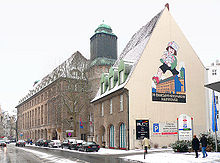
Former Bahlsen cookie factory (today its administration, location52 .3896119 .751959 )
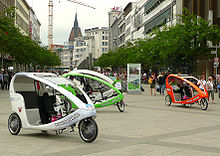
Bicycle cabs at the main station
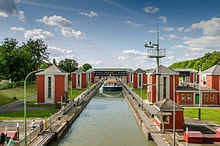
Anderten Lock (Location52 .3603859 .864817 )
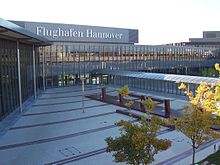
Hannover-Langenhagen Airport (Location52 .4586019 .696778 )
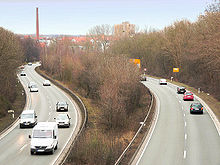
Westschnellweg (Lage52. 3637199.708557 )

Hanover S-Bahn train

Route network of the Hanover light rail system

Hanover Central Station (Location52 .3764559 .740979 )
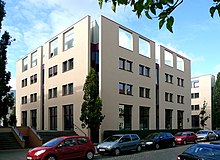
Lower Saxony Criminological Research Institute at Welfenplatz (Location52 .3874619. 742234 )

Youth hostel Hannover, seen from the other side of the river Ihme (Lage52 .3542659 .730437 )
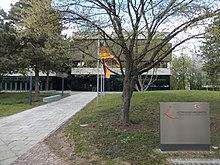
Gottfried Wilhelm Leibniz Library - Lower Saxony State Library (Lage52 .3652949 .730847 )
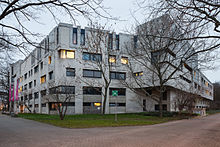
Hanover University of Music, Drama and Media (Location52 .3774729 .754036 )
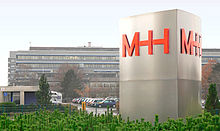
MHH (location52 .3838729 .806168 )

Main building of the University of Hannover in the Welfenschloss (Location52 .3822859 .717821 )
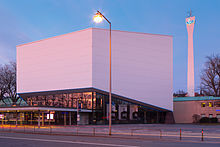
NDR-Landesfunkhaus Hannover, on the left the large broadcasting hall (Lage52 .3602759 .742055 )
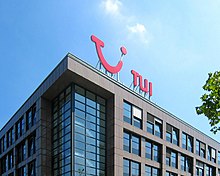
TUI AG Group Headquarters
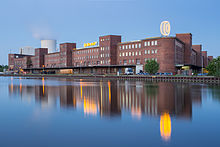
Continental AG (Hanover-Stöcken plant)
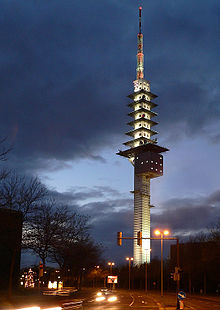
Telemax in the district of Groß-Buchholz
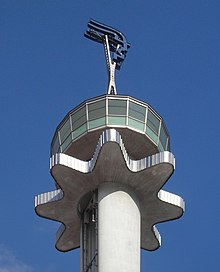
The top of the Hermes Tower at the fairgrounds (location52 .3210879 .802756 )

Ernst-August-Galerie (Location52 .3771059 .73934 ) and VW Tower
Personalities
Honorary citizen
→ Main article: List of honorary citizens of Hannover
Persons who have rendered outstanding services to Hanover are awarded honorary citizenship. Originally, they were granted free citizenship rights. Honorary citizens include Georg Friedrich Grotefend (decipherer of the cuneiform script), the national liberal politician Rudolf von Bennigsen and Reich President Paul von Hindenburg, who resided in Hanover from 1911 to 1914 and from 1919 to 1925.
Since the Second World War, a total of ten personalities have received honorary citizenship, including the former German Chancellor and Prime Minister Gerhard Schröder and the artist Niki de Saint Phalle. The most recent honorary citizen to be awarded the title was Herbert Schmalstieg, the long-serving Lord Mayor, on February 2, 2007.
Native Hanoverian
→ Main article: List of native Hanoverians
- The master brewer Cord Broyhan was the inventor of a new light beer.
- The siblings Friedrich Wilhelm Herschel and Caroline Herschel were researchers and astronomers.
- In 1882, the mathematician Ferdinand von Lindemann succeeded in proving that squaring the circle is impossible.
- The brother of the inventor of the record and the gramophone Emil Berliner, Joseph Berliner, founded the world's first gramophone factory in Hanover.
- Theodor Lessing and his wife Ada Lessing, who was born here, founded the adult education center in Linden.
- The artist Kurt Schwitters developed his form of Dadaism in Hanover.
- The political philosopher Hannah Arendt was born in Linden, which was independent at the time, and spent her early years in the city.
- Curt Frankenstein, later a U.S. visual artist, grew up on the Eilenriede.
- The serial killer Fritz Haarmann committed 27 murders in Hanover.
- The Gerrit Engelke Prize, which was awarded by the city of Hanover until 2007, commemorated the poet Gerrit Engelke.
- Rudolf Augstein founded the magazine Der Spiegel in Hanover in 1947.
Other native Hanoverians include playwright Frank Wedekind, artist and writer Karl Jakob Hirsch, aviation pioneers Elly Beinhorn and Karl Jatho, physicist and co-discoverer of quantum mechanics Pascual Jordan, Germany's first female engineer Ilse ter Meer, dance avant-gardist Mary Wigman, and actors August Wilhelm Iffland (the Iffland Ring is named after him) and Theo Lingen.
Well-known native Hanoverians of the present include Ernst August Prinz von Hannover, the cartoonist Uli Stein, the director Doris Dörrie, the authors Friedhelm Kändler and Alexa Hennig von Lange, the actors Renate Becker, Otto Sander, Kai Wiesinger and Maria Schrader, the painter Heimar Fischer-Gaaden, the soccer players Fabian Ernst and Per Mertesacker, the cyclist Grischa Niermann, the singers Klaus Meine and Mark Morrison, the comedian Oliver Pocher, the conceptual artist Manfred Kohrs, the singer Lena Meyer-Landrut and the politician Annalena Baerbock.
More Hanoverian
→ Main article: List of non-native Hanoverians
Gottfried Wilhelm Leibniz, one of the most famous philosophers and polymaths of his time, lived in Hannover. The architect Georg Ludwig Friedrich Laves shaped Hanover in the style of classicism. The founder of the Hanover School of Architecture, Conrad Wilhelm Hase, attracted architects such as Paul Rowald and Edwin Oppler to Hanover in the 19th century. Dieter Oesterlen left his mark on the city's postwar architecture. Other Hanoverians who moved here included the centrist politician and minister Ludwig Windthorst, the draftsman, painter and poet Wilhelm Busch, the painter and graphic artist Ernst Marow, the painter, draftsman, graphic artist and sculptor Kurt Sohns, the cultural politician Adolf Grimme (Grimme Prize), the inventor of the PAL system Walter Bruch and the former rector of the TiHo Hannover Karl Enigk.
Currently residing in Hanover are former German Chancellor Gerhard Schröder, former German Minister Edelgard Bulmahn, sociologist and political scientist Oskar Negt, Hungarian musician and director of the European Center for Jewish Music Andor Izsák, cabaret artist Matthias Brodowy, and music producer Mousse T.

Herbert Schmalstieg: Long-time mayor, honorary citizen and native of Hanover
See also
![]()
Portal: Hanover - Overview of Wikipedia content related to Hanover
Questions and Answers
Q: What is the population of Hanover?
A: The population of Hanover is 522,944 (1 February 2007).
Q: What are some big industry companies located in Hanover?
A: Some big industry companies located in Hanover include Volkswagen (Cars and Vans), Continental (tyres), Varta (batteries) and TUI (tourism).
Q: What are some famous attractions in Hanover?
A: Famous attractions in Hanover include a modern zoo, an international airport, the CeBIT Centre of Office, Information and Telecommunication, the traditional Hanover fair, Expo-2000, the Eilenriede forest near the inner city, Maschsee lake near the city centre and Herrenhausen gardens.
Q: Who is the mayor of Hanover?
A: The mayor of Hanover is Stefan Weil who followed Herbert Schmalstieg in 2006. Both are from the social democratic party SPD.
Q: How do people get around town in Hannover?
A: People get around town by using Hannover Hauptbahnhof which has been around since 1843.
Q: Are there any internationally famous inhabitants from Hannover?
A: Yes, some internationally famous inhabitants from Hannver include classic rock band Scorpions, former German chancellor Gerhard Schröder and association football player Per Mertesacker.
Q: What are some key employers in this region?
A: Key employers in this region include Volkswagen, Continental Talanx ,Hannove Re ,Nord LB and VHV.
Search within the encyclopedia
.svg.png)
.JPG)



